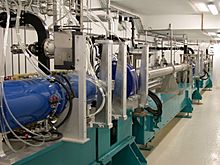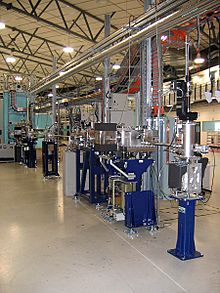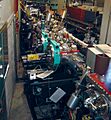Beamline facts for kids
A beamline is like a special path for tiny particles or powerful light beams. Scientists use these paths in big machines called particle accelerators to study all sorts of things.
Imagine a super-fast highway for invisible particles or light! Beamlines help guide these beams to a specific spot where experiments happen. This allows scientists to learn about materials, chemicals, and even living things at a very tiny level.
Contents
Beamlines in Particle Accelerators

Inside a particle accelerator, a beamline is usually a long, hollow tube. It's often buried underground in a special tunnel. This tube is made of metal and is sometimes called a "beam pipe."
To make sure the particles can travel very far without hitting anything, the inside of the beamline must be almost completely empty. This is called a very strong vacuum, meaning there's hardly any air inside.
Special teams carefully line up each part of the beamline using lasers. Everything must be perfectly aligned, sometimes to within a tiny fraction of a hair's width! Good alignment stops the beam from hitting the pipe walls. If the beam hits the walls, it can create unwanted energy or even harmful radiation.
Synchrotron Light Beamlines
At a synchrotron, a beamline is the equipment that carries powerful beams of light to an experiment area. This light comes from a large, circular machine called a synchrotron. Scientists use this light for many different studies, like looking at the structure of crystals.
A big synchrotron lab can have many beamlines. Each one is designed for a specific type of research. They can be very long, sometimes over 100 meters (328 feet)! Building these beamlines is very expensive, costing millions of dollars.
Safety in Beamline Areas
The parts of a beamline are kept inside special shielded rooms called hutches. These hutches are like small cabins. A typical beamline has two hutches: one for preparing the light beam and another for the actual experiment.
People are not allowed inside the hutches when the light beam is on. Hutches have complex safety systems that make sure no one is inside when the beam is active. If a door to a hutch is opened by accident while the beam is on, the safety system will immediately turn off the entire synchrotron beam. This means opening one door can shut down all the experiments at the facility!
Beamline Equipment
Scientists use different tools along the beamline to prepare the light beam before it reaches the experiment:
- Windows: Thin sheets of metal, often beryllium, that let most of the beam pass through. They keep the vacuum inside the machine safe.
- Slits: These control the size and spread of the light beam.
- Focusing mirrors: Special mirrors that help to focus the light beam, making it stronger and more precise.
- Monochromators: Devices that select specific colors or types of light from the beam. They block out other unwanted light.
- Sample stages: Platforms where scientists place the material they want to study. These stages can move the sample and change its temperature or pressure.
- Radiation detectors: Tools that measure the light after it has interacted with the sample.
All these tools help control the heat from the beam and make sure the right kind of light reaches the experiment. The entire beamline is kept under a very strong vacuum.
Neutron Beamlines
A neutron beamline is similar to a synchrotron light beamline, but it uses neutrons instead of light. Neutrons come from special machines like research reactors. Scientists use neutron beamlines to study how neutrons bounce off different materials. This helps them understand the material's structure.
Related pages
- Accelerator physics
- Cyclotron
- Ion beam
- Category:Neutron facilities
- Klystron
- Particle accelerator
- Particle beam
- Particle physics
- Quadrupole magnet
- Waveguide
Images for kids
-
Beamline at Brookhaven National Laboratory.





